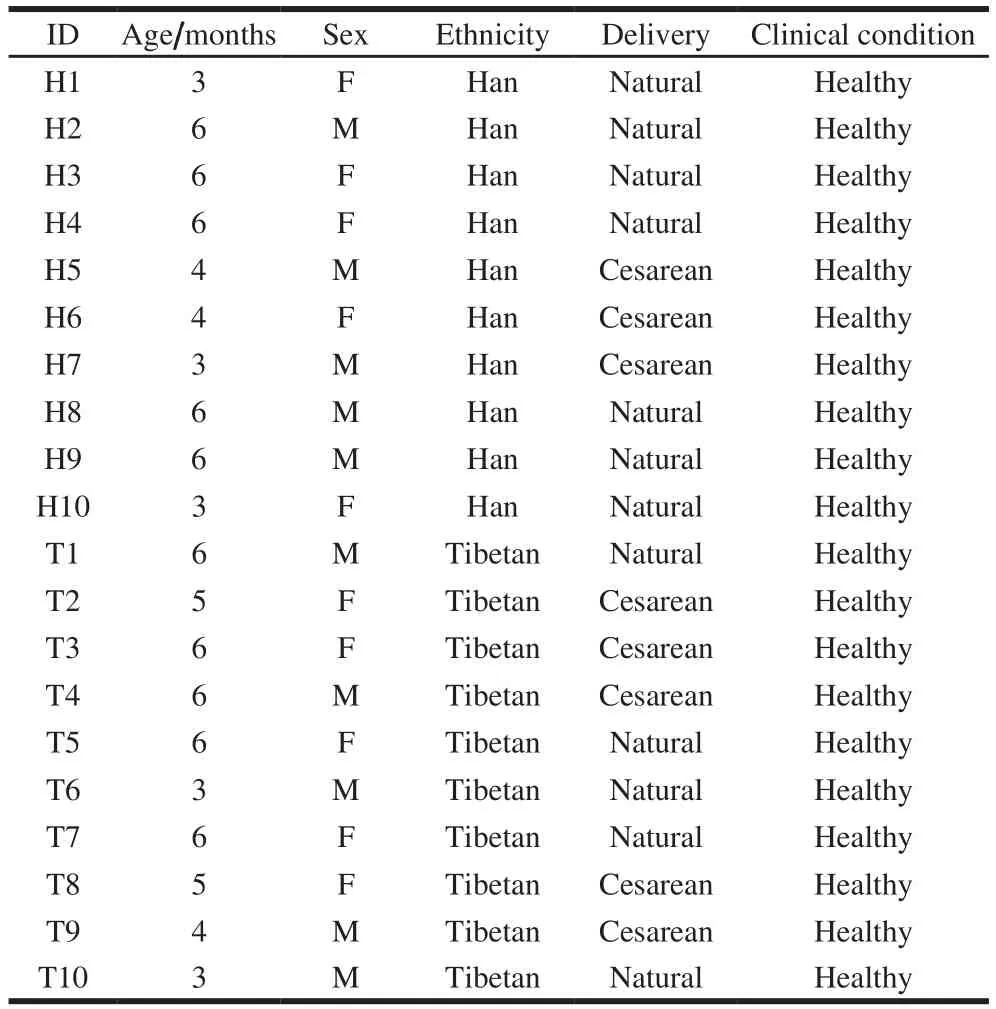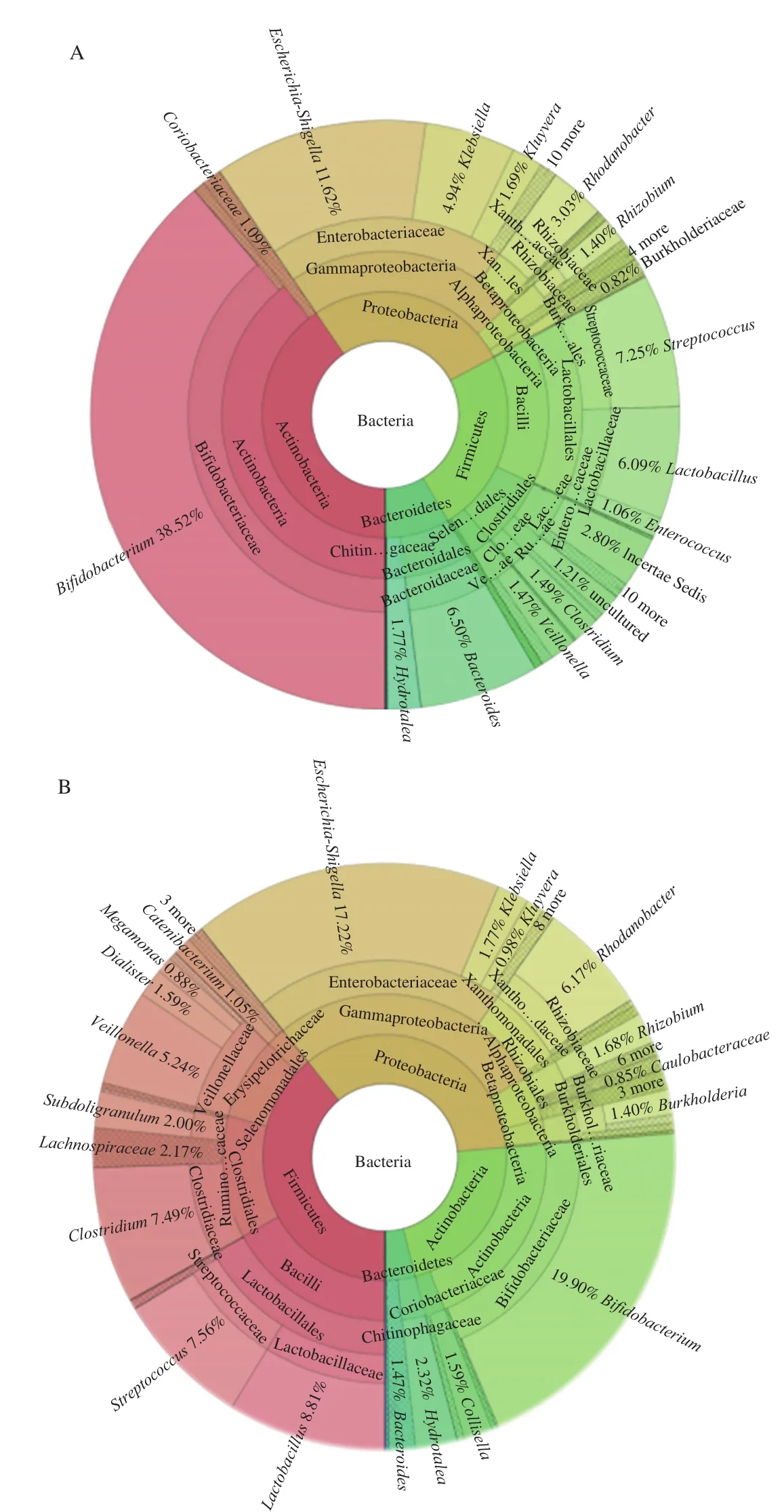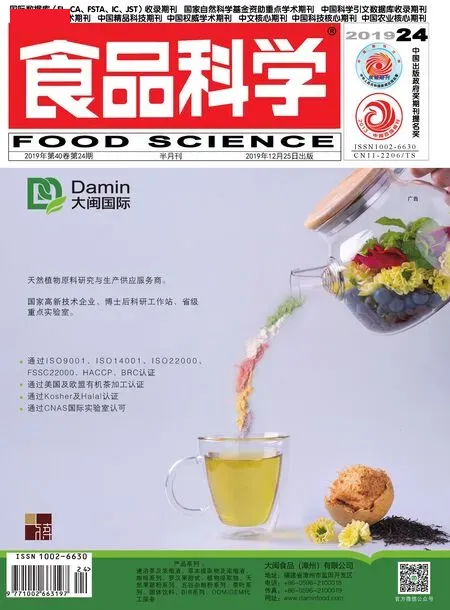Structural Segregation of the Gut Microbiome between Chinese Han and Tibetan Infants
ZHANG Qiuxue, SHANG Jiacui, ZHU Dequan,2, ZHU Zongtao, WAN Feng, JIA Fangfang,SUN Sirui, MENG Xiangchen,*
(1. Key Laboratory of Dairy Science, Ministry of Education, Synergetic Innovation Center of Food Safety and Nutrition,Northeast Agricultural University, Harbin 150030, China; 2. College of Science, Jiamusi University, Jiamusi 154003, China)
Abstract: Ethnicity is considered as one of the major driving forces to shape the human gut microbiota, but how the gut microbiota evolves in population with disparate ethnic backgrounds since infants are born remains still unclear. Thus, this study aimed to understand the impact of ethnicity on infants. We investigated the fecal microbiota of healthy infants (3-6 months old, with breast feeding) from the Chinese Han and Tibetan ethnic groups (n = 10 for each group). By using highthroughput 16S rRNA gene sequencing analyses, we found some differences in fecal microbiota composition between the two groups. At the phylum level, the Han infants harbored higher relative abundance of Actinobacteria, whereas Firmicutes was more predominant in the Tibetans. A significant difference at the phylum level existed in Firmicutes (P < 0.05)between the two groups. Bifidobacterium and Escherichia-Shigella were the first and second major genera in both groups,respectively. There was a clear separation between the groups by principal coordinates analysis (PCoA) based on unweighted and weighted UniFrac distance. Moreover, partial least squares-discriminant analysis (PLS-DA) showed that the infant gut microbiome was segregated according to ethnicity. Taken together, our findings suggest that the gut microbiota could be differentiated between infants from distinct ethnic origins, and this expanded our knowledge of the co-evolution of human hosts and their symbiotic gut microbiota.
Keywords: infant; gut microbiota; ethnicity; co-evolution
The initial gastrointestinal microbiota development plays an important role in host health and is related to several diseases throughout the human lifetime, because the microbiota and the human host are of mutualistic interactions[1-2]. Within the infant period, the microbiota is dynamic[3]. Many factors can influence the acquisition and establishment of infant gut microbiota, including delivery mode[4], feeding practices[5], antibiotic therapy[6], probiotics and prebiotics[7]and geography[8], etc.
Furthermore, the microbiota colonized in mother’s gut and derived milk microbiota is also one major factor that shapes gut microbiota of healthy breast-feeding infants.Researchers have found that human milk may significantly influence infant gut microbiota colonization[9]and is also a source of commensal bacteria for the infant gut[10]. It has also been shown that there is a vertical transfer of gut lactic acid-producing bacteria from the mother’s gut to the derived milk, which can be further transferred through the milk to the infant’s gut[11-15]. Such microbial transmission from mother to infant through breast-feeding is further affected by ethnicity,which is important to shape the infant gut microbiota[16-17].For example, the composition of gut microbiome in African American was different from that of non-African Americans in both neonates and infants due to the difference of mothers’ethnicities[18].
It is necessary to explore the development process of infant gut microbiota and characterize the difference between ethnic groups[19]. Qinghai-Tibet plateau, the highest plateau on the world, is a typical high altitude region in China,with typical environmental conditions such as geographical locations of high altitude and climate conditions, including low temperature, low barometric pressure, low humidity, and high radiation[20]. Moreover, Tibetan ethnic group is one of the three largest traditional nomadic tribes in China keeping up until now, and they have particular cultural background and dietary habits such as Zanba, bitter tea. Tibetans generally have higher energy intakes like more meat and less vegetables than Chinese Han, the largest ethnic group in China. Previous studies showed that the Han adults had different gut microbial community composition and diversity from those of Tibetan adults[21-22]. However, it is not clear that whether the gut bacterial diversity of healthy breast-feeding infants is different among different ethnic groups in China,a multicultural society consisting of the major ethnic group Han and other ethnic minority groups.
In this study, we determined the gut microbial diversity of healthy breast-feeding infants in Tibetan and Han ethnic groups, aiming at comprehending two matters: firstly, to understand the microbial diversity of the Han and minority Tibetan infants; and secondly, to find out the general relationship between microbiota and ethnicity in infants by identifying whether there is compositional difference in gut microbiota between the two distinct ethnic groups.
1 Materials and Methods
1.1 Materials and reagents
QIAamp DNA Stool Mini Kitand QIAquick Gel Extraction kit were obtained from QIAGEN; PicoGreen dsDNA Assay Kit was obtained from Invitrogen; the primers of PCR was 338F: ACTCCTACGGGAGGCAGCA and 806R: GGACTACHVGGGTWTCTAAT[23]; and the PCR mixture contained 5 μL of Q5 reaction buffer (5 ×), 5 μL of Q5 High-Fidelity GC buffer (5 ×), 0.25 μL of Q5 High-Fidelity DNA Polymerase (5 U/μL), 2 μL (2.5 mmol/L)of dNTPs, 1 μL (10 μmol/L) of each Forward and Reverse primer, 2 μL of DNA Template, and 8.75 μL of ddH2O.
1.2 Instruments and equipment
NanoDrop ND-1000 spectrophotometer was obtained from Thermo Fisher Scientific (Waltham, MA, USA);GeneAmp PCR system 9700 was purchased from Applied biosystem (USA); DYY-10C electrophoresis apparatus was obtained from XX (Beijing, China), Illumina MiSeq platform was obtained from Personal Biotechnology Co. Ltd.(Shanghai, China).
1.3 Methods
1.3.1 Subject selection and fecal sample collection
We enrolled 20 healthy infants born and living in the Nyingchi, Tibet Autonomous Region (five males and five females) and Harbin, Heilongjiang province (five males and five females), China, respectively. All the infants were breastfeeding for 3-6 months without other supplements such as infant formula and any additional foods. There were no use of probiotics or antibiotics for these infants, nor the food allergies or gastrointestinal diseases in three months before collecting samples. Moreover, Tibet and Harbin infants’parents were indigenous residents and Tibetans’ parents are native nomadic tribes.
The fresh fecal samples were collected and put into sterile fecal collection tubes, and then stored at -80 ℃ until genomic DNA extraction. An informed consent was provided and confirmed by their legal guardians before participation.
1.3.2 DNA extraction and 16S rRNA gene amplification
DNA extraction, PCR amplification, amplicons sequencing and sequence analysis were all performed by Shanghai Personal Biotechnology Co. Ltd.. The physical wall-breaking procedure of glass concussion, to prepare fecal microbiota DNA, was executed followed by extracting the genomic DNA of each fecal sample using QIAamp DNA Stool Mini Kit according to the manufacture’s manual.The quality of extracted DNA was assessed by agarose gel electrophoresis and the ratio of optical density (OD) at 260 nm/280 nm was measured by spectrophotometry. The extracted DNA was stored at -20 ℃ until further processing.
For each sample, the V3-V4 hypervariable regions of 16S rRNA gene were amplified by PCR using the primers 338F and 806R. Sample-specific 7 bp barcodes were incorporated into the primers for multiplex sequencing.Thermal cycling consisted of initial denaturation at 98 ℃ for 2 min, followed by 25 cycles consisting of denaturation at 98 ℃ for 15 s, annealing at 55 ℃ for 30 s, and extension at 72 ℃ for 30 s, with a final extension of 5 min at 72 ℃. Positive amplicons were examined by agarose gel electrophoresis and purified with QIAquick Gel Extraction kit. Then they were quantified using the PicoGreen dsDNA Assay Kit.
1.3.3 High-throughput sequencing and diversity analysis
After the individual quantification step, amplicons were pooled in equal amounts, and pair-end 2 × 300 bp sequencing was performed using the Illumina MiSeq platform and MiSeq Reagent Kit v3. Sequences of an average phred score lower than 30, ambiguous bases, homopolymer runs exceeding 6 bp, primer mismatches, or sequence lengths shorter than 100 bp were both removed. High-quality sequences were retained for further study, and operation taxonomic units(OTUs) were clustered at 97% similarity using UCLUST in Quantitative Insights into Microbial Ecology (QIIME,v1.8.0) with open-reference OTU picking[24]. Taxonomy of each OTU was identified against Greengenes database(Release 13.8). Rarefaction curve and species accumulation curve were calculated by QIIME and R “vegan” package,respectively[25-26]. Chao1 and ACE indices were used to estimate richness, while Shannon and Simpson indices were used to evaluate microbial diversity[27].
The UniFrac-based Beta diversity of gut microbiota from each sample pair was evaluated and computed using the OTU table. UniFrac is a set of phylogenetic distance metrics that can measure the microbial community similarity[28-29].
Linear discriminant analysis effect size (LEfSe) was used to determine taxa differentiated between two ethnic groups[30], and the effect size threshold was set to be more than 2 (on a lg scale). The relative abundance of genus-level taxa was further analyzed via partial least squares-discriminant analysis (PLS-DA) to visualize the difference between two ethnic groups[31].
2 Results and Analysis
2.1 General characteristic of infant gut microbiota
In this study, the fecal microbiota of 20 healthy infants were characterized (Table 1). In total, 1 142 217 high-quality sequences were generated after filtering from all 20 fecal samples, with an average of 47 837 tags per sample. These reads were subsequently clustered into 5 946 OTUs at the 97% similarity level.

Table 1 Detailed information of each participant infant
Although no OTU level rarefaction curves plateaued under the current sequencing depth, all the species accumulation curves reached plateau values, indicating that most of the microbial diversity had already been captured in this data set though there was a possibility to detect rare new phylotypes with additional sequencing efforts.
2.2 Microbial richness and diversity
The microbial richness and biodiversity were compared between the two ethnic groups. Both indices were evaluated using a similarity threshold of 97% in order to test selectivity in the definition of OTUs. The indices (± s) of Chao1,ACE, Simpson, Shannon of Han group was 368.89 ± 62.69,356.14 ± 58.03, 0.75 ± 0.19, 3.21 ± 1.06, while it was 414.75 ± 98.21, 405.89 ± 105.96, 0.83 ± 0.15, 3.69 ±0.84 in Tibetan group, respectively. Analysis of variance(ANOVA) revealed no statistical significant differences in the community richness and biodiversity between two ethnic groups (P > 0.05).
2.3 Taxonomic profiles of gut microbiota in Han and Tibetan infants
We detected 10 phyla across all the fecal samples,and more than 98% of the dominant phyla of Han and Tibetan groups were Firmicutes (24.06% versus 38.53%),Protebacteria (26.58% versus 33.96%), Actinobacteria(40.21% versus 21.93%), Bacteroidetes (8.36% versus 3.75%), respectively (Fig. 1). At phylum level, the most predominant phylum in Han group was Actinobacteria,while Firmicutes was the most predominant phylum in Tibetan group.
The relative abundances of predominant genera in two ethnic groups were shown as heatmap (Fig. 2). The predominant genera included Bifidobacterium (38.52%versus 19.57%) and Escherichia-Shigella (11.62% versus 16.94%) in Han and Tibetan groups. In the Han infants,other predominant taxa included Streptococcus (7.25%),Bacteroides (6.5%), Lactobacillus (6.09%), Klebsiella(4.94%), Rhodanobacter (3.03%), Incertae sedis (2.78%),Hydrotalea (1.77%), and Clostridium (1.49%), while Tibetan infants harbored Lactobacillus (8.67%), Streptococcus(7.44%), Clostridium (7.37%), Rhodanobacter (6.07%),Veillonella (5.16%), Hydrotalea (2.28%), Subdoligranulum(1.97%), and Klebsiella (1.74%) (Fig. 3). Among these genera, there were no statistically significant differences between Han and Tibetan groups.

Fig. 2 Heatmap of relative abundance distribution the major 50 genera
Besides the above dominant genera, others with more than 1% abundance in Han group were Kluyvera (1.68%),Veillonella (1.47%), Rhizobium (1.4%), Enterococcus(1.06%) while Rhizobium (1.66%), and Collinsella (1.57%),Dialister (1.56%), Burkholderia (1.38%), Catenibacterium(1.04%) in Tibetan group.
Particularly, Bacteroidetes principally included Bacteroides and Hydrotalea in Han group, whereas in Tibetan group it mainly consisted of Hydrotalea, Prevotella (0.72%)and Bacteroides (0.6%).

Fig. 3 Composition of the major genera in gut microbiota of Chinese Han infants (H group) (A) and Tibetan infants (T group) (B)
LEfSe was employed to compare the differences in infant gut microbiota between Han and Tibetan ethnic groups. The relative abundances of Firmicutes, Dialister,Leuconostocaceae, Pantoea, Howardella, and Alloscardovia,Leuconostoc in Tibetan group were higher than those in Han group, while the abundance of Proteus, Micrococcales, and Phenylobacterium were higher in the gut microbial of the Han group as compared to that of the Tibetan group (Fig. 4).

Fig. 4 Difference in abundance of bacterial communities assessed by LEfSe
The variation in the composition of microbial communities between two groups could be assessed by principal coordinates analysis (PCoA) based on unweighted UniFrac distance (which considers the presence/absence of the microbial members) and weighted UniFrac distance (which incorporates the relative abundance of each phylotype). A separation between two groups could be found by weighted UniFrac PCoA, this difference was significant with a non-parametric permutation analysis of similarity (ANOSIM) test (R=0.149 8, P=0.031, 1 000 permutations; Fig. 5A). The ANOSIM test on the unweighted UniFrac distance also revealed a distinction between the gut microbiota of two groups (R=0.196 4, P=0.007, 1 000 permutations; Fig. 5B). Furthermore, PLS-DA revealed that the gut microbiota structure of the two ethnic groups were differentiated from each other (Fig. 6).


Fig. 5 Weighted UniFrac principal coordinates analysis plots according to weighted UniFrac metric (A) and unweighted UniFrac principal coordinates analysis plots according to unweighted UniFrac metric (B)

Fig. 6 PLS-DA score plot between Chinese Han infants and Tibetan infants group
3 Discussion
Our study focused on the gut microbiota in Han and Tibetan infants, and we found different fecal microbiota compositions between the two ethnic groups, but no significant differences in diversity. Our study has provided additional evidence that different ethnic groups may contribute to infants’ gut microbiota.
In our study, the results shown that more than 98%of bacteria belonged to the Actinobacteria, Bacteroidetes,Firmicutes, and Proteobacteria phyla, in agreement with the previous study that the four phyla contributed to the majority of infant gut microbiota[32]. At the genus level, the Bifidobacterium was the most dominate genus in both ethnic groups, probably due to the fact that these samples were collected from breast-feeding infants. Human breast milk is known to harbor various oligosaccharides[33-34]. Human milk oligosaccharides are indigestible polymers formed by several kinds of monosaccharides that serve as prebiotics by selectively stimulating growth of members of the genus Bifidobacterium[35-37]. Similarly, previous studies also reported Bifidobacterium as the most abundant genus in Malawian and finnish 6 months healthy infants, and further suggested that Bifidobacterium may play a critical role in promoting breast-fed infants’ health across distinct ethnic groups on the world[38].
Moreover, the richness and biodiversity of Tibetan group were both higher than those of Han group in the study which was in agreement with previous reports, a report has shown that diversity in feces was significantly higher in Yanomami than in U.S subjects and a similar study has been found that rural Africa children had a significant higher differences in richness and biodiversity than European[39-40]. At the same time, the gut microbiome differs substantially between rural Papua New Guineans and United States residents, which could stand for nonindustrialized and westernized societies have been studied by some researchers, they found the fecal microbiota in former was more diverse than latter, then they proposed a model by which reduced bacterial dispersal due to modern lifestyle practices causes microbiome alterations associated with westernization[41-42]. And as we know, Tibet has low economic status and some of them keep their lifestyle of nomadic. This may explain lower urbanization presented more microbial diversity not only in children and adult gut tract, but also in infants’ gut tract though infants’gut microbiota is unstable and not yet fully established and matured.
The Firmicutes was the only phyla that had significant differences in gut microbiota between the two ethnic groups.Because the major genera Lactobacillus, Streptococcus,Clostridium, Veillonella, Subdoligranulum and Dialister which belong to Firmicutes in Tibetan group were both higher than those in Han group. And the genera of Subdoligranulum and Clostridium are more abundant in Tibetan group because of their living environment, as we have known, infants of Tibetan group live at high altitudes (2 900 m) and infants of Han group live at low altitudes (128 m). Infants living at high altitude may need higher energy to adapt the lower oxygen environment, and SCFAs produced by the gut microbiota can provide energy for Tibetan infants[43].
On the other way, mother milk-derived microbiota and environment exposure which both influenced by geography may explain the differences in the composition of gut microbiota between Chinese Han and Tibetan infants[8,14].The mother-neonate communication hypothesis that maternal gut tract bacteria reach breast milk by an entero-mammary pathway to inf l uence infant gut colonization[44]. And mothers from two groups had different diets which contribute to the difference in their gut microbiota. Especially Tibetans mothers mainly received diets standing for traditional geography characteristics like Zanba, which is semisolid or solid mixture of cooked highland barley power, yak butter and salt tea[45]. The environment exposure such as the hygiene of house dust and drinking water[46], family structure[47],pets and some animals[48], surrounding the newborn is also a natural source of microbes that can colonize in different body sites. As we know native Tibetans are nomadic tribes with many kinds of animals and have special environment conditions[19].
4 Conclusions
In conclusion, we found some differences in the gut microbiota between two groups. This study provided a more comprehensive understanding of the diversity and structure of the gut microbiota in Han and Tibetan infants. Although a series of studies focused on the infant gut microbiota,only few of them considered the impact of ethnicity. Our results could provide a reference to future researches on the infant intestine. As host genetics and mode of delivery also have influence on infant gut microbiota colonization and development, it is necessary to unravel the interrelations between diversity and the activity of the gut microbiota and other potential factors such as ethnicity comprehensively.

